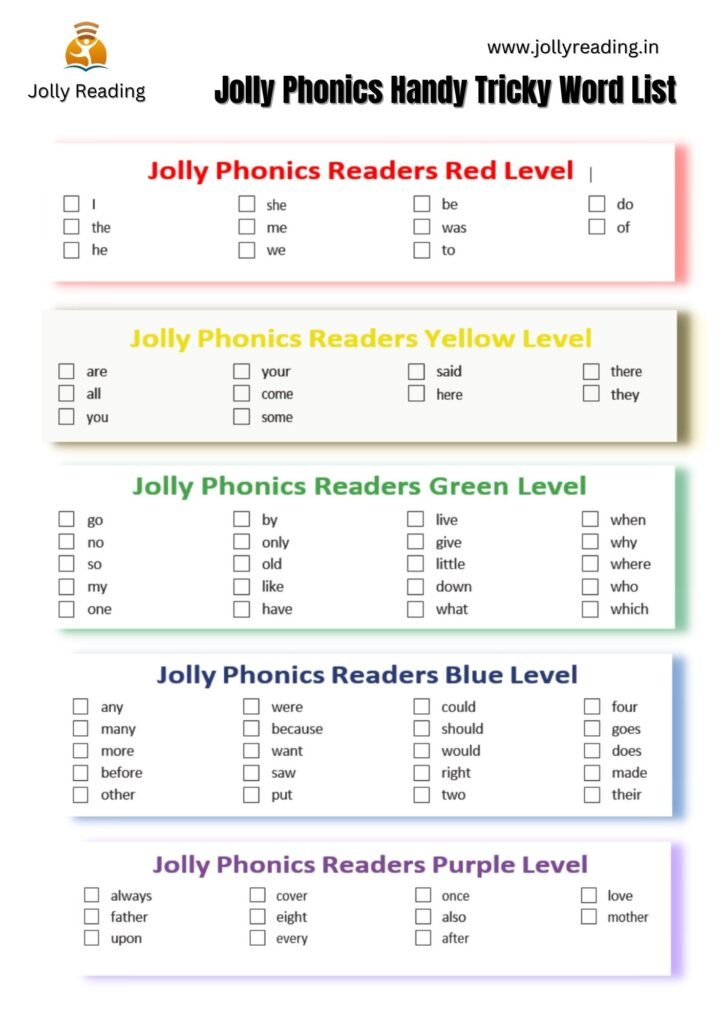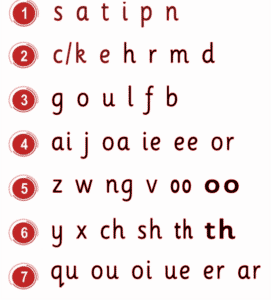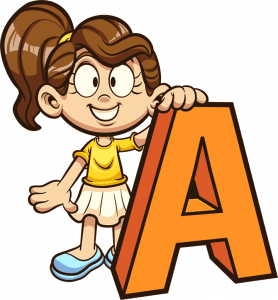
Table of Contents
Jolly Phonics Handy Tricky Word List
Jolly Phonics Readers Red Level Tricky Word List
| I | the | he | she | me | we |
| be | do | was | of | he | to |
Jolly Phonics Readers Yellow Level Tricky Word List
| are | your | said | there | all |
| come | here | they | you | some |
Jolly Phonics Readers Green Level Tricky Word List
| go | by | when | no | only | why |
| so | old | little | where | my | like |
| down | who | one | have | what | which |
Jolly Phonics Readers Blue Level Tricky Word List
| any | were | could | four | many |
| because | should | goes | more | want |
| would | does | before | saw | right |
| made | other | put | two | their |
Jolly Phonics Readers Purple Level Tricky Word List
| always | cover | once | love | father | after |
| eight | also | mother | upon | every |
The Fundamentals of Jolly Phonics and Its Approach to Teaching Reading and Writing:
Jolly Phonics is a teaching method used to help children learn how to read and write. It is based on the idea that children can learn the sounds of the letters of the alphabet (Phonics) and use this knowledge to read and spell words. In Jolly Phonics, each letter of the alphabet is associated with a specific sound, and children are taught to blend these sounds to read and write words. The method also includes interactive and engaging activities, such as games and songs, to help children learn and remember the letter sounds. Jolly Phonics aims to provide children with a strong foundation in Phonics, enabling them to become confident and proficient readers and writers.
The Importance of Tricky Words in Early Reading and Writing Development
• What are Tricky Words, and Why are They Important?
Tricky words, also known as sight words or high frequency words, are words that cannot be sounded out using phonics. These words are important for early reading and writing development because they are common words that occur frequently in text, but cannot be easily decoded using phonics. Therefore, it is important for children to learn these words by sight in order to read and write fluently.
Some examples of tricky words include “the,” “said,” “have,” and “was.” These words are called tricky words because they do not follow the usual phonetic rules, and must be learned by sight.
• Strategies for Teaching Tricky Words
Teaching tricky words can be challenging, but there are a number of strategies that can be used to help children learn them. These strategies include repetition, flashcards, and word walls. It is also helpful to provide children with plenty of opportunities to read and write using these words in context.
- Repetition: Do activities through flashcards, word drills, and reading books containing tricky words. Repeating the tricky words with children and having them practice reading and writing them can help them learn and remember them.
- Word walls: Creating a word wall with the tricky words displayed prominently can provide children with a visual reference to help them learn and remember the words.
- Flashcards: Using flashcards with tricky words written on them can be a helpful tool for teaching and reinforcing the words. Children can practice reading the words by looking at the flashcards and saying the words out loud.
- Reading and writing in context: Providing children with opportunities to read and write using the tricky words in context can help them understand the meaning and usage of the words. This can be done through activities such as reading and writing sentences or stories containing tricky words.
- Collaborative learning: Working with a partner or small group can provide children additional support and encouragement as they learn the tricky words. Collaborative activities such as word games and quizzes can be engaging and help build confidence in reading and writing tricky words.
• Using Tricky Words in Reading and Writing Practice:
Overall, the importance of tricky words in early reading and writing development cannot be underestimated. By learning these words, children can improve their reading fluency, comprehension, and overall language skills.
Examples of Tricky Words and Tips for Teaching Them
Here are some examples of tricky words and tips for teaching them
“said” – This word is often used in conversation and is important for children to learn to understand and participate in spoken language. One tip for teaching this word is to have children repeat it after you in a sentence, such as “She said, ‘I’m hungry.'”
“have” – This word is important for children to learn to use correctly in their writing. One tip for teaching this word is to have children use it in a sentence, such as “I have a toy.”
“was” – This word is often used in the past tense and is important for children to understand and use verb tenses correctly. One tip for teaching this word is to have children use it in a sentence, such as “I was at the park yesterday.”
“the” – This word is a common article used to indicate a specific noun. One tip for teaching this word is to have children use it in a sentence, such as “The cat is sleeping.”
“come” – This word is an important verb used to indicate movement toward the speaker. One tip for teaching this word is to have children use it in a sentence, such as “Come here.”
It is important to provide children with plenty of opportunities to read and write using these words in context and to give them plenty of support and encouragement as they learn these challenging words.
Strategies for Practicing and Mastering Tricky Words
- Practice regularly
- Use mnemonic devices
- Break the word down
- Use visual aids
- Learn root words and word origins
- Read and write frequently
- Look up and learn the definition of the word
- Use word lists or spelling bees
- Spell the word out loud
- Write the word multiple times
- Use the word in a sentence
- Take a break
Encouraging and Supporting Children as They Learn Tricky Words
- Provide a positive and supportive learning environment
- Use fun and interactive learning tools
- Encourage children to take breaks
- Offer praise and encouragement
- Use visual aids
- Use mnemonic devices
- Make learning a social activity
- Set achievable goals
- Seek help from a tutor or teacher
The Role of Tricky Words in the Overall Phonics Curriculum
Tricky words, also known as sight words, are high-frequency words frequently appearing in text and are difficult to sound out using phonics skills. They are introduced in a phonics curriculum to help children become more fluent readers and recognize common words quickly and automatically. Tricky words are an important part of a comprehensive phonics curriculum. Still, teaching children strategies for decoding unfamiliar words is also important.
The Benefits of Using Jolly Phonics to Teach Tricky Words
Jolly Phonics is a widely used method for teaching children to read and write using phonics skills. It is designed to be fun and interactive. It uses various activities and resources to help children learn phonics skills, including tricky words
Some benefits of using Jolly Phonics to teach tricky words include:
It is highly structured: Jolly Phonics follows a clear and systematic approach to teaching phonics skills, including introducing tricky words. This can help children feel more confident and secure in their learning.
It is multi-sensory: Jolly Phonics uses a range of activities, including songs, games, and hands-on activities, to engage children’s different learning styles. This can make learning tricky words more enjoyable and effective.
It teaches children strategies for decoding unfamiliar words: In addition to teaching tricky words, Jolly Phonics also teaches children strategies for decoding unfamiliar words, such as blending sounds and using word attack skills. This can help children become more independent readers.
In addition to teaching tricky words, Jolly Phonics teaches children strategies for decoding unfamiliar words, such as blending sounds and using word attack skills. This can help children become more independent readers.
It is widely used and proven to be effective: Jolly Phonics has been used successfully in schools and homes around the world and has been shown to be an effective method for teaching children to read and write using phonics skills.
Conclusion
Are you ready to help your child become a confident and independent reader? At Jolly Reading, we have the resources and expertise to support your child’s reading journey. Our Jolly Phonics & Advanced Phonics program is tailored to meet the needs of each child and is designed to help them succeed. Please don’t wait any longer to give your child the reading skills they need to succeed in the future. Enroll in our program today and watch your child become a confident and independent reader.







